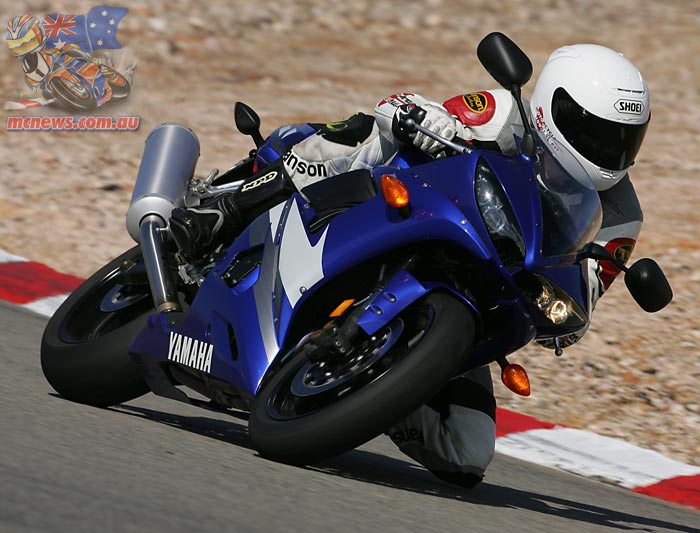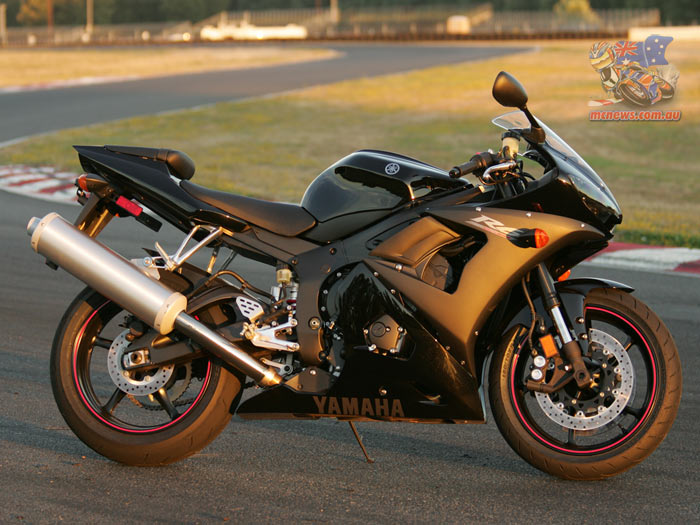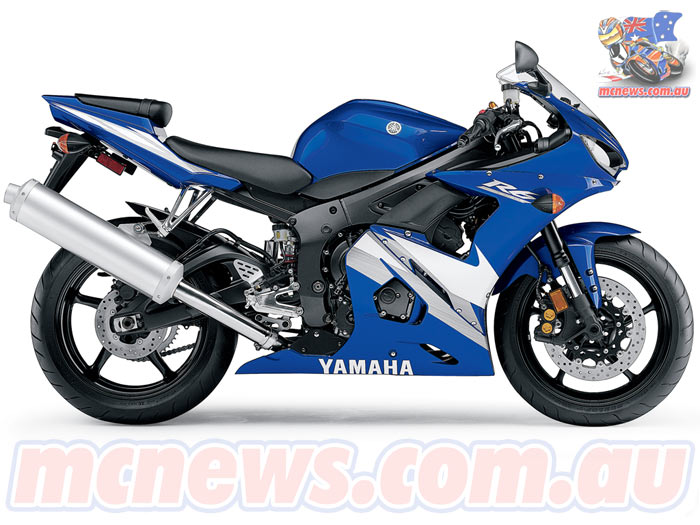
- Yamaha YZF-R6 2005
Scorching around Willow Springs raceway on Yamaha’s new 600cc Supersport weapon, I am filled with amazement. Sharing the track with me, Speed Channel’s Greg White is filming a small segment for Two Wheel Tuesday and this just blows me away. Here we are riding the latest cutting edge 600cc Supersport, a bike that can cut lap times hotter than a Grand Prix motorcycle from two decades ago, and all it warrants is a few minutes of television time. (Viewer interest, not Greg’s programming choice).
Meanwhile, over on the Chopper Channel, millions of people will be eagerly awaiting the steroid family’s next bowel movement, as they tune in for a half hour of dysfunctional motorcycle butchering.
While the happy family were busy hacking and welding away, to ensure their latest monstrosity handles and stops like a bloated pig on roller skates, Yamaha’s highly trained engineers were hard at work to analysis changes in their chassis that the addition of an inverted fork would cause. Then, as the latest overpaid celeb forked over some disgustingly large wad for their personal art deco nightmare, Yamaha were figuring how to make these changes and more, while still offering the motorcycle to the general public for around 15 grand.
But unfortunately sport bike fans, for some reason good television this does not make. I guess at least when these things get in the hands of Messrs. Gobert, Hacking etc. all the ratings are higher, but even then compared to Europe they are nothing to write home about.
Anyhow, enough of my soapbox and back to the task at hand, discussing the new R6 from Yamaha. I am obviously highly impressed with the beast, hence my prior ranting, but what’s so special about the bike this year? The most noticeable change for ’05 is the new inverted front fork with radial mount brake calipers attached.
The forks are 41mm Kayaba items, multi adjustable in all the usual ways and offering greater rigidity over last years conventional 43mm unit. In discussions with ex Superbike Champion Jamie James he felt they really only pay dividends when being pushed on the track under race conditions, but they certainly add heavily to the bike’s street cred for those of us who don’t ride that hard.
The new forks retain their 120mm of travel, but now use a stronger spring weight and stiffer standard damping settings. This relates to superb control under braking, the bike exhibiting little dive, without being harsh anywhere else on the track. I personally would like a steering damper. Under acceleration over the rise at Willow the front end goes very light and the bars will start a flapping.
The forks are tastefully adorned with some seriously butch looking radial mounted calipers which are the absolute dogs bollocks when it comes to slowing the bike from speed. Partnered in crime by a Brembo design radial pump brake master cylinder, they are at least on par or perhaps even better than anything currently offered as original equipment.

The four-piston Sumitomo calipers are lifted straight from the current R1 with only the pad material differing between the applications. The lever has a more precise screw type adjuster compared to last year’s multi position wheel, making it is easy to set the lever exactly where you want it. As hard as I rode all day, once set, I didn’t have to make any compensation for it getting closer to the bar as I didn’t experience any brake fade.
Some other changes have also been made up front. For ’05 the discs are now increased from 298mm to 310mm, but have been reduced 4.5mm in width to reduce weight. We must be talking grams here.
The rake and trail figures are also changed from 24 degrees and 86mm to 24.5 degrees and 95mm, no doubt to give the bike more stability. These changes to the front and rear end combine to give the bike a 5mm longer wheelbase. The front is also now 15mm higher but there is no change in width to report.
Yamaha’s intended mission had been to improve the front end and leave everything else well alone. Unfortunately it wasn’t that simple, the new set up created handling problems that necessitated a revised rear suspension link and some stiffening in the frame around the swing arm pivot area. This was also to compliment the new 70-series profile front tyre the R6 runs this year. The higher profile is the race tyre size of choice, and is said to give the bike a more solid feel in the corners.
At the rear a new relay arm raises the seat height 10mm. Like at the front end a stiffer spring rate is used: 103 N/mm compared to 98 N/mm in case anyone understands such things is the figures in relation to the Soqi shock. The method of adjustment remains the same but the base settings are stiffened up some. Ride quality is superb, I experienced no squat from the rear under hard acceleration and it dealt with the bumpy section of the track with ease.
Externally this year’s bike looks very similar to the ’04, but there are some subtle cosmetic changes with a new R1 fender up front, a new headlight lens and a different inner cowling. Truth be told, I was actually a tad disappointed when I first saw the bike in person. The new R1 is just such an incredibly sexy machine that the six looked somewhat understated. Getting it out on the track though all this was quickly forgotten, as I started to explore what the bike could do, but more of that in a minute.
Looking in behind the new fairing you will notice the R6 uses two smaller fans in place of last years bigger side mounted one. What didn’t change was the R6’s exhaust system, and I have to admit with the R1 running an under tail exhaust I would have thought it to be a natural for the six.
There have been some changes to the engine’s power output though. Yamaha have coaxed three additional ponies from the horsepower department for a claimed ram air assisted maximum of 120 at the crankshaft.
This increase has solely been found in the fuel injection system, the rest of the engines internals remain the same as last year.
The throttle bodies have been enlarged from 38mm to 40mm, the air funnels reshaped and the ECU re-tuned. These changes are said to not affect the low and the midrange output, in a full-throttle racetrack situation I wasn’t able to notice any change.
What I did notice was how smooth the engine was, and how quickly it built revs without seeming to have a big power surge anywhere in the range.
The rev limiter shuts the fun down at the 15,500 rpm red line. Peak horsepower is made at 13,000 rpm so there is little to be gained other than watching a tachometer get close to hitting 16,000rpm. Maximum torque remains 49 ft-lbs at 12,000rpm, the same as last year, and the figure is quoted with assistance of the ram air.
In the morning, perhaps when temperatures were cooler and I wasn’t running the engine so high in the rpm, I noticed some abruptness in the fuel injection coming back on the throttle after hard braking. I would like to try the bike on the road to see if this is a problem, or just a hiccup in my particular test bike.
For the first part of our test we ran on the standard fitment Dunlop Sportmax radial tyres with a little suspension tweaking by the Yamaha technicians. The tyres worked well to a point, but a nasty slide before lunch reminded me they had seen action during an earlier road launch and to take it easy.
The bike was phenomenally easy to ride, allowing faultless gear changes, handling way beyond my capabilities and even stronger brakes than last year’s model: Nothing surprising here!
After lunch the bikes were all wearing Dunlop D208GP-JLB race tyres. Immediately upon hitting the track I found my groove, but the capable handling R6 had disappeared to be replaced with a machine that felt hinged in the middle and decidedly unstable through the fast turns. Removing a few clicks of pre-load on the rear shock took some emphasis off the more triangulated front tyre and harmony was restored at the controls. Although by this time the famous Willow Springs wind was coming at us hard through the long turn eight which made for an interesting ride.
No such problems back in turn one through five which are out of the wind, the race compound tyres sticking to the track tighter than one of Donald Trump’s apprentices to his derrière. This allowed me to push harder and brake later than with the street tyres and the R6 was completely in control, not one ruffled feather from my meager riding abilities.
All the controls are typical Yamaha and work perfectly. Gear shifting is by thought, throttle opening, clutch and brake operation are as smooth and easy as they could be. The ride position is pure sport, and works perfectly on the track with the foot pegs actually 9mm higher this year to gain some additional ground clearance. The bars remain the same, as does the 17-litre fuel tank and seat width, so the long term R6 owner is going to feel right at home when they upgrade.
Final conclusions about the R6: It is everything it ever was and more, with improved stability, better brakes and more power. The new R6 is going to continue winning friends and influencing people. It is also going to be tough to beat on the track.
And, while I lament the lack of attention bikes like this receive on television, I am beginning to think maybe it’s a good thing? If the Chopper crowd figured out how much more fun they could be having for a fraction of the price, maybe someone would work out they should be charging a whole lot more for sportsbikes. Take advantage while it lasts!
Specifications – 2005 Yamaha YZF-R6
Engine – 600cc, liquid cooled, four-stroke, four cylinder
Bore x Stroke – 65.5 x 44.5mm
Compression Ratio – 12.4:1
Induction – EFI with 40mm throttle bodies
Ignition – Digital CDI
Gearbox – Six speed
Front Suspension – Fully adjustable 41mm inverted forks
Rear Suspension – Full adjustable single shock
Front Brakes – Dual 310mm discs with radial-mount four-piston calipers
Rear Brake – 220mm disc with single piston caliper
Tyres – 120/70ZR17 (F), 180/55ZR17 (R)
Length x Width x Height – 2024 x 691 x 1090mm
Wheelbase – 1379mm
Rake / Trail – 24.0° / 86mm
Seat Height – 820mm
Dry Weight – 162kg
Fuel Capacity – 17 litres
























